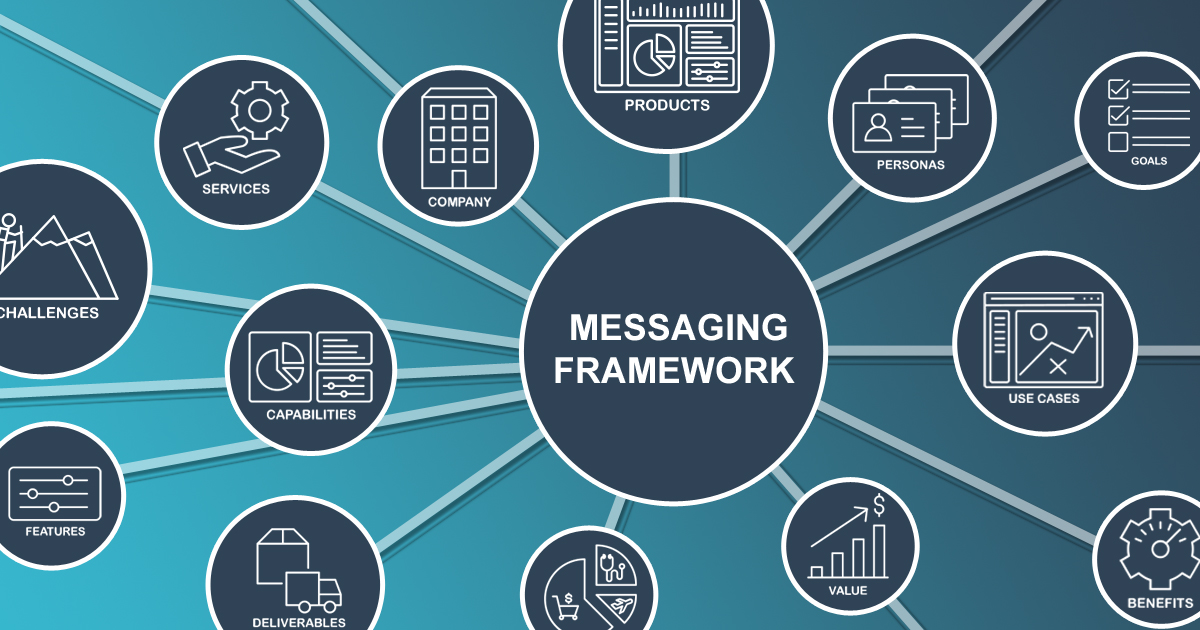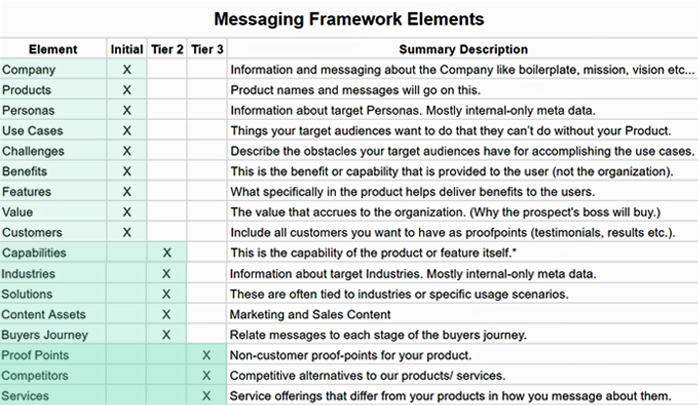
Messaging Framework Essentials: Choosing the “Right” Elements and What to Do Next
Jonathan Bracken
The title may sound preachy, but rest assured, this post is less like a prescription and more like a menu. I’ll provide a reasonable list of elements to include in your messaging framework without specifying exactly which ones to choose. Okay, I may sprinkle in some strongly suggested bits here and there.
I’ll explore a more holistic “framework,” capable of covering all your product messaging and even some of your corporate/brand messaging. If you’re only looking for a simple piece of a framework like “personas” or “feature/benefits,” this might be overkill. For the rest of you, here we go:
Select the “Right” Elements to Begin your Framework
Map Out Your Initial Framework Elements
Choosing the elements for your framework is as important as looking at a map before a long drive. Well, at least it was back when there weren’t any mobile phones or nav systems. Prep time with your map helps identify where you’ll spend time (messaging-wise) for a while, so get this right.
Having said that, don’t feel like your selections are set in stone. You’re simply choosing initial framework elements, knowing you’ll likely add more in the future as your company and marketing evolves.
Select Manageable Framework Elements
In general, you should start with a manageable set of messaging elements—you can also call them objects, dimensions, etc. In GrokSpark, we refer to them as “Message Types.” For this initial set, add main messaging elements you have a strong knowledge of and are able to handle complexity-wise.
Your “knowledge” truly makes this list manageable—it eliminates the need for any big research project to create new elements. Include high-level (business value) AND low-level (feature/capability detail) messaging elements for each of your defined target audiences.
Include Features in Your Initial Framework Elements
Combat the “don’t talk about features” trend—it’s rare that a B2B company should NEVER talk about features. Plan to talk about everything you need in order to cover each stage of the buyers’ cycle. Later, you can even break down your messaging by stage.
Since there isn’t much differentiation in high-level messaging around business value, you’ll eventually need to dive into product-proof. For example, you’ll need to show how your product can actually deliver the business value you’re claiming.
If you’re in a highly-mature, competitive space (e.g. CRM), you’ll need to communicate product features sooner rather than later in order to effectively position yourself.
Don’t Skip this Step
Define Each of Your Framework Elements
You must also come up with a definition for each of the elements in your framework. No need to be fancy, but writing these down will help you think through potential areas of confusion or overlap. You don’t want to be working with your new messaging framework for six months and then think, “Wait, what’s the difference between my ‘features’ and my ‘capabilities’?”
Write it down now so you can get to that Mutually Exclusive and Collectively Exhaustive (MECE) list. Define your framework elements to ensure you have all the necessary Product Marketing messages to communicate to your various audiences.
Example Framework Element List
Here’s an example list of what you might want to start with. It’s based upon things we’ve had some success with in the past and it’s what we typically provide out-of-the-box for our customers today. The initial core elements are:
- Company – What’s the name of your Company?
- Products (or services) – What are the names of your Products?
- Personas – Who are your Products for?
- Use Cases – What do they want to do that they can’t do today or is very difficult for them to do today (without your Product)?
- Challenges – What are the major obstacles for accomplishing the use cases? (These could be challenges related to potential loss or hard-to-reach achievement goals.)
- Benefits – What does your product enable them to do that helps users overcome these challenges?
- Features – What specifically in the product gives them these benefits?
- Value – What is the value that accrues to the customer’s organization?
- Customers – Include all customers you want to have as proof-points in your messaging.

This list should grow as you mature, or as your target market matures along with your understanding of it. Additional elements that enable increased targeting like solutions or industries are good to have on hand.
Now Sweat the Small Stuff
Tend to the Details of Your Messaging Framework
Now that you’ve selected and defined your framework elements, there are some useful details to consider. Looking at your list you now need to determine some of the key properties you want to have for each message of each element type.
For example, for Products it’s always helpful to have a number of descriptions of varying lengths to support different uses. You’ll use short descriptions for Adwords and social posts versus beefier ones for long-form emails or blog posts. Throw in descriptions for tradeshows/events so you can keep and maintain them all in one place.
In cases where the properties themselves require definition, DO IT! If you intend to have multiple framework users in your organization, make sure definitions are written in a helpful way. For each element property, it’s helpful to write “instructions” for how to create the message as well as “examples”.
When other team members are responsible for writing marketing messaging, this step ensures everyone creates messaging in a consistent way. When each framework element has multiple properties, it can get somewhat complicated to produce consistent messaging without writing it down.

Sample properties for core messaging elements with instructions and examples.
How to Write Your Actual Framework Messaging?
Here’s How to Write Your Framework Messaging
Some people I’ve worked with grappled with the question of how to write the messaging for their framework. My opinion is strongly (starting to sound a little ‘preachy’!) that you should write your messaging as it is intended to be read by (or spoken to) a prospect, or by whomever is in the intended target audience.
Here’s How Not to Write Your Framework Messaging
You might be tempted to write in sort of a training style for the sales reps or growth marketing team. Don’t. This causes confusion since the “official messaging” you give them can’t be used directly in communications or content. It slows the process of communications, reduces consistency and are you sure they are all better copywriters than you are?
You can give individuals and internal teams background info in other docs, training materials etc. It might even be possible to include some meta-data for the properties (to accompany the instructions and the examples). But be sure to keep all the actual messaging properties written the way you’d want your prospects to read it.
Choose the Tone & Style of Your Framework Messaging
Choose a tone and style that’s consistent with your brand, but clear and easy to parse for your target audiences. For messaging specific to a target audience, you can adjust the tone/style accordingly. Be careful here, though.
It’s incredibly important to remain consistent in your approach for each audience. If you are only introducing an alternative tone/style for part of the buyers’ journey, you’ve introduced unnecessary inconsistency. Instead, where possible try to be clear, concise, and authentic.
Next Steps
Done With Your Messaging Framework, or Nah?
If you’ve been writing your messaging as you were reading, then you likely have a big pile of words in some sort of doc. If it looks great and easy to use for your organization, then congratulations! You’re done with this blog post series and can skip the third installment.
For the rest of you, read on in Post #3 where I’ll discuss how to structure your messaging framework and which format/tool to use so that you can get the most value out of it for your organization (hint: it’s not the same answer for everyone!).